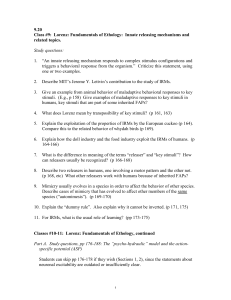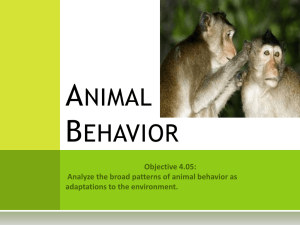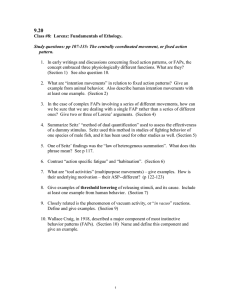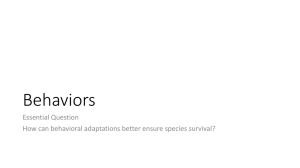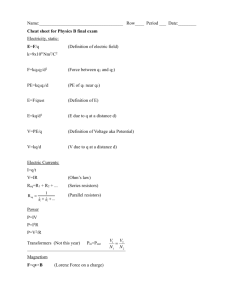9.20
advertisement
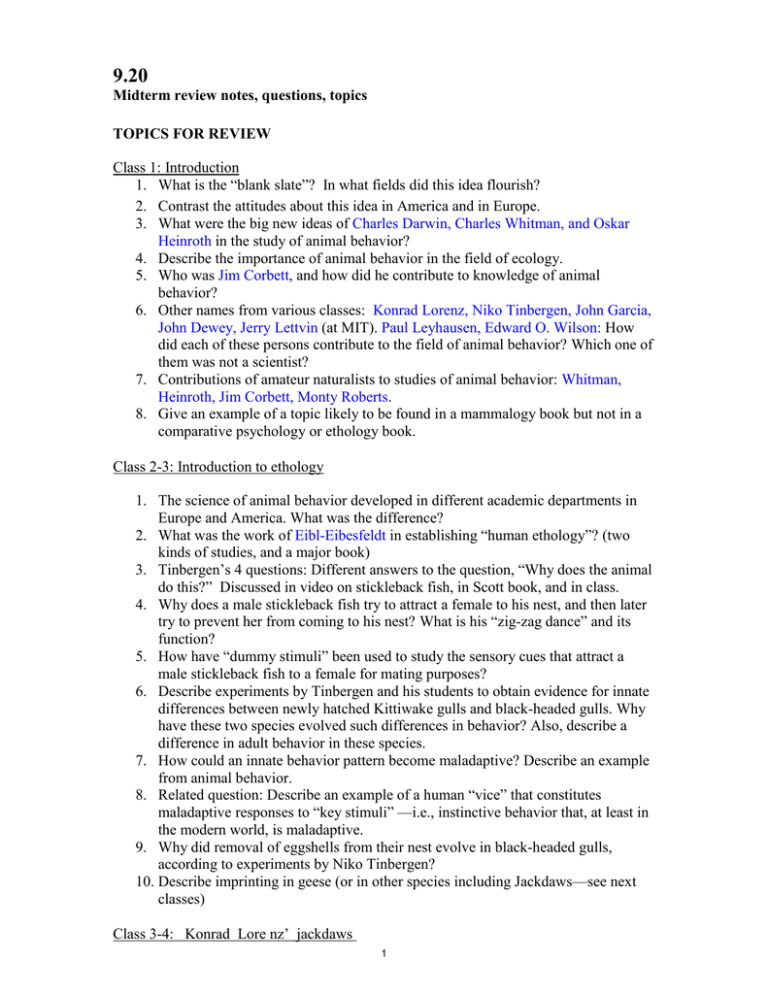
9.20 Midterm review notes, questions, topics TOPICS FOR REVIEW Class 1: Introduction 1. What is the “blank slate”? In what fields did this idea flourish? 2. Contrast the attitudes about this idea in America and in Europe. 3. What were the big new ideas of Charles Darwin, Charles Whitman, and Oskar Heinroth in the study of animal behavior? 4. Describe the importance of animal behavior in the field of ecology. 5. Who was Jim Corbett, and how did he contribute to knowledge of animal behavior? 6. Other names from various classes: Konrad Lorenz, Niko Tinbergen, John Garcia, John Dewey, Jerry Lettvin (at MIT). Paul Leyhausen, Edward O. Wilson: How did each of these persons contribute to the field of animal behavior? Which one of them was not a scientist? 7. Contributions of amateur naturalists to studies of animal behavior: Whitman, Heinroth, Jim Corbett, Monty Roberts. 8. Give an example of a topic likely to be found in a mammalogy book but not in a comparative psychology or ethology book. Class 2-3: Introduction to ethology 1. The science of animal behavior developed in different academic departments in Europe and America. What was the difference? 2. What was the work of Eibl-Eibesfeldt in establishing “human ethology”? (two kinds of studies, and a major book) 3. Tinbergen’s 4 questions: Different answers to the question, “Why does the animal do this?” Discussed in video on stickleback fish, in Scott book, and in class. 4. Why does a male stickleback fish try to attract a female to his nest, and then later try to prevent her from coming to his nest? What is his “zig-zag dance” and its function? 5. How have “dummy stimuli” been used to study the sensory cues that attract a male stickleback fish to a female for mating purposes? 6. Describe experiments by Tinbergen and his students to obtain evidence for innate differences between newly hatched Kittiwake gulls and black-headed gulls. Why have these two species evolved such differences in behavior? Also, describe a difference in adult behavior in these species. 7. How could an innate behavior pattern become maladaptive? Describe an example from animal behavior. 8. Related question: Describe an example of a human “vice” that constitutes maladaptive responses to “key stimuli” —i.e., instinctive behavior that, at least in the modern world, is maladaptive. 9. Why did removal of eggshells from their nest evolve in black-headed gulls, according to experiments by Niko Tinbergen? 10. Describe imprinting in geese (or in other species including Jackdaws—see next classes) Class 3-4: Konrad Lore nz’ jackdaws 1 1. What are properties of jackdaws that made them so interesting for study by the 22-year old Konrad Lorenz? (Three properties were mentioned in class.) 2. What are adaptive functions of play? Which animals do it? 3. “Like the stones of a mosaic, the inherited and acquired elements of a young bird’s behaviour are pieced together to produce a perfect pattern. But, in a bird that has been reared by hand, the natural harmony of this design is necessarily somewhat disturbed.” Describe an example of this. 4. Why should we expect care of young to be largely innate in animals? How could you look for learned components of this behavior? 5. How do jackdaws recognize predators? Distinguish innate and acquired components. 6. Describe two kinds of evidence for recognition of individuals by jackdaws. 7. Describe a behavior pattern that indicates a pairing of jackdaws. How long before actual mating does this occur? How long do such pairs remain paired? What behaviors occur frequently between members of a mature pair? Konrad Lorenz and his students: studies of geese (video & discussion) 1. Imprinting: Describe its unique properties. Give an example of how it can lead to disturbances in “the natural harmony” of nature when an animal is reared by a human. - Student –“The goose doesn't develop it's natural behaviors?” - Imprinting: it is unique in that there is a sensitive or critical period in which it occurs, and it is irreversible after it happens. The goose does develop its natural behaviors but it may respond to abnormal stimuli, e.g., it may try to mate with humans. 2. Mobbing—describe for two species, and indicate its functions. - We saw mobbing responses in geese and in meerkats, in response to predators. It communicates to the predator that it has been detected and that they can most likely get away from him. It also communicates that he is outnumbered and may get injured. 3. How do young geese learn their social rank, according to experiments by Lorenz and his students at Seewiesen, Germany? - Geese learn social rank from observing how their mother interacts with other geese. They learn her rank and assume a similar rank. 4. How is a young goose that is imprinted on a human “parent” taught to fly by the human? Compare with learning to walk. How is a young goose that is imprinted on a human “parent” taught to fly by the human? Compare with learning to walk. Class 5-6: Ethology and the CNS 1. A recent analysis (published in 2011) of studies of whether geese have innate anti-predator responses to hawks reached conclusions that differed from those of earlier claims. What was the main conclusion? 2. FAPs in humans? Give examples. How do we know they are largely innate? 3. FAP vs reflex: How do they differ? [see also class 8] 2 4. What are sign stimuli, or key stimuli, in animal behavior? Are they complex or simple? (See also class 9.) 5. What are “supernormal stimuli”? Examples in studies of birds. Examples of how such stimuli are used to influence human behavior. 6. Neuron types: primary sensory, secondary sensory, and motor neurons. Where do interneurons fit in? 7. Neuroethology of vision: role of midbrain tectum (discussed for frog and toad, and for hamster) 8. See class 9 for the contribution of Lettvin at MIT. He studied “IRMs” in frogs. Summarize a major finding of his work on frogs. 9. How the Brazilian wandering spider catches prey in the air without using vision: the key stimulus. 10. Contrast “command neuron” and “motor neuron”? 11. Advantage of giant axons in squid or crayfish? 12. What is an “ethogram”? [Class notes, beginning of class 6; discussed more extensively in class 12] A recent analysis (published in 2011) of studies of whether geese have innate antipredator responses to hawks reached conclusions that differed from those of earlier claims. What was the main conclusion? Neuroethology of vision: role of midbrain tectum (discussed for frog and toad, and for hamster) Jerry Lettvin’s contribution at MIT to the study of IRMs Contrast “command neuron” and “motor neuron”? Class 6-7: Motivational states 1. Homeostatic mechanisms, including behavior: specific examples 2. Temperature regulations: contrast the roles of behavior in a reptile and in a mammal. 3. Appetitive and consummatory behavior (distinct components of any FAP): contrast them with examples from animal behavior. 4. Two major types of thirst, with different sensory inputs that cause the thirst 5. The hormone leptin: What is it? Can it explain hunger? 6. Short-term vs long-term regulators of feeding behavior: specific examples. Experiments that demonstrated the role of certain short-term regulators, including stimuli from the mouth and throat. 7. “Hedonic…regulation can override the homeostatic pathway during periods of relative energy abundance….” What is meant by “hedonic regulation”? It can lead to specific addictions, including food addictions. 8. Types of motivational control of behaviors: cyclic and episodic types. Give examples of each. 9. Endogenous and exogenous controllers of activity rhythm (the “circadian rhythm”). Discovery of a specific biological clock that regulates activity cycles. 3 10. Definitions of “free running” rhythm; “entrainment” of a rhythm. 11. Why do animals sleep? Answers can be of different types: the adaptive functions that caused it to evolve; a behavioral instinct (FAP) with specific key stimuli; brain mechanisms. 12. Ultradian rhythms. 13. Describe adaptive functions of sleep, each of which may have influenced its evolution. 14. Biphasic sleep; multiphasic sleep. Describe a specific example. Short-term vs long-term regulators of feeding behavior: specific examples. Experiments that demonstrated the role of certain short-term regulators including stimuli from the mouth and throat. Endogenous and exogenous controllers of activity rhythm (the “circadian rhythm”) Class 8: Lorenz’ Fundament al s of Ethology 1. Three distinct processes involved in a Fixed Action Pattern: Note the difference between the concepts of a fixed action pattern and a fixed motor pattern. What are the other components of the FAP? 2. Intention movements: What are they? In the evolution of behavior, some intention movements have become “ritualized” to serve as social signals. Major example: ritualized aggression/fighting among conspecifics. Why is such ritualized behavior so important, more for some species than for others? 3. A fixed action pattern can involve a series of actions. How can we know that it is a single FAP and not several? (We discussed Lorenz on the “unity of motivation.”) What are two of the arguments? (Class 8 slide 8) 4. Define an “IRM” and the role of key stimuli. Seitz produced evidence from studies of fish that the effects of key stimuli are additive (his law of heterogenous summation). 5. Threshold lowering: Describe specific examples. 6. What is “in vacuo” behavior? 7. What are three multipurpose actions (tool activities) that are used in a great many fixed action patterns? (See also class 12.) 8. What is an Action Specific Potential (ASP), and how, without external stimulation, does the speed of its build-up vary among different FAPs? (Recall the study of cats by Paul Leyhausen.) 9. Seitz’ law of heterogenous summation: What, specifically, is summated? 10. Define “action-specific fatigue.” Is it really fatigue? 11. In contrast to action-specific “fatigue,” How can one demonstrate that habituation of an innate response depends on central changes that are not on the motor side of the pathway of information flow? 12. List responses, overt and not-so-overt, to novel stimuli. Separate behavioral responses and responses resulting from autonomic nervous system activity. (See also chapter 12.) 13. Hunting and feeding: Describe evidence that they are distinct FAPs using specific examples. 4 What is “in vacuo” behavior? Define “action-specific fatigue.” Is it really fatigue? Class 9: Innate releasing mechanisms; other topics from Lorenz 1. Jerry Lettvin’s contribution at MIT to the study of IRMs 2. The simplicity of key stimuli can be indicated by maladaptive responses (in animals or in humans). Describe examples. See also class 13. 3. What is the “dummy rule”? 4. But why do some FAPs require complex stimuli to elicit them? 5. How does the European cuckoo or the Whydah bird (both “social parasites”) exploit properties of IRMs of other species? 6. Studies of interactions between Great Spotted Cuckoo birds and Magpies in Spain has yielded evidence for what has been called the “Mafia hypothesis.” Briefly, what is this hypothesis? (It concerns attempts of magpies to resist the brood parasitism by the cuckoos, and the cuckoos’ responses.) 7. Releaser: definition and examples. (It is not an IRM, but an IRM responds to it. It has evolved to provide key stimuli for eliciting a fixed action pattern.) 8. Releasers and key stimuli that affect human behavior; how they are exploited for commercial purposes. 9. Automimicry in evolution: meaning and examples What are sign stimuli, or key stimuli, in animal behavior? Are they complex or simple? (See also class 9.) Define an “IRM” and the role of key stimuli. Seitz produced evidence from studies of fish that the effects of key stimuli are additive (his law of heterogenous summation). Why do some FAPs require complex stimuli to elicit them? Class 10-11: More from Konrad Lorenz 1. The Tinbergen and the Lorenz models of FAP organization: What are key differences? What are the major strengths of each model? 2. Give examples of the “inertia of excitation” in human and animal behavior. 3. In what ways can innate behaviors (instincts), called fixed action patterns, be flexible? (Recall the parental behavior of the female digger wasp, studied by Tinbergen. Also, remember the learning by cats to link various FAPs for hunting behavior.) 4. Closely related: Examples of how certain behavior patterns that serve as appetitive behavior in feeding may have ASPs independent of the FAP they normally serve (e.g., in feeding by ducks, cactus finches, in hunting by cats or dogs). I.e., they are independent FAPs, but in normal experience they usually become linked (via learning). 5 5. What does Lorenz claim to be the main reason a head had to evolve in evolution? Explain an additional reason. 6. How, in general, has the function of the “head ganglion” changed in higher vertebrates, with respect to FAPs? (p 209) 7. How can reflexes conceal the rigidity of fixed motor patterns? 8. Ability to solve a detour problem: Why it is not always a good test of intelligence? 9. Describe how facial expressions of threat by dogs appear to have evolved from superpositions. 10. Multiple simultaneous motivations: consequences if very strong. Describe 3 ways of dealing with the conflict that have been studied in animal behavior. Give examples of each way. 11. Insight in apes: What is it, and what is the evidence? 12. How can one distinguish between higher and lower animals using behavioral abilities? Ability to solve a detour problem: why it is not always a good test of intelligence Animals differ in their reflexes and FAPs. Some can solve the problem using innate responses alone. What does Lorenz claim to be the main reason a head had to evolve in evolution? In class you learned of additional reasons. How can one distinguish between higher and lower animals using behavioral abilities? What does Lorenz claim to be the main reason a head had to evolve in evolution. In class you learned of additional reasons. In Lorenz’ view, why did the head, containing the “locus of superior command”, have to be invented in evolution? (p 206-207) To limit behavior to one motor pattern at a time. Setting priorities among motivational states To embody the IRMs for selection of a motor pattern (FAP). [Most stimuli come into the brain through the cranial nerves.] System-wide modulation, “states” How, in general, has the function of the “head ganglion” changed in higher vertebrates, with respect to FAPs? (p 209) Increased linkage between innate and learned aspects of behavior. Initiation of behavior patterns driven by learned motivations and cognitive decisions. Cognitive level: at the top of the neural hierarchy but not always dominant More centralized planning; stronger executive functions How can one distinguish between higher and lower animals using behavioral abilities? Examples from chimp and gorilla problem solving o Evidence for the formation of plans within an internal model, within which places and events can be anticipated and alternatives can be considered. “Higher” may be answered in terms of anticipation abilities: A unique role of the neocortex. o Special role of the prefrontal association areas of the neocortex in planning 6 What animal has, in relative terms, the largest prefrontal cortex? o A brain system superimposed on others: the grammatical language system (dependent on both frontal and posterior multimodal association areas of the neocortex) o Superimposed on, and highly interconnected with, systems embodying both spatial and object memories. o The associations allow symbolic representations and reasoning o Weakly developed, if developed at all, in most animal species Class 12-13: Evolution; development and plasticity of behavior 1. Three basic multipurpose behaviors (tool movements) of almost all animals. In vertebrates, outputs of the midbrain control each of these behaviors. (Also mentioned in class 8) 2. The “mantle of reflexes” for the background support of behavior, enables stability of the internal mileau and stability in space 3. The regulators, or controllers, of behavior are the “drives”, associated with FAPs and learned habits. In vertebrates, midbrain mechanisms are involved, but the forebrain mechanisms have become more dominant. 4. Write a partial outline of the regulators of behavior—basic drives (associated with FAPs)—i.e., start an outline of an ethogram. 5. What are some drives, with their own ASPs, related to ingestion behaviors but nevertheless distinct from hunger and thirst? 6. Responses to novel stimuli have been discussed. There is a motivation to seek novelty (the curiosity drive), most pronounce in advanced, large-brained vertebrates. See also above, chapter 8. 7. Lie detection uses the same measures used to measure aspects of the orienting response (to novel stimulation). What is the similarity between reactions to novelty and reactions to a lie? 8. Describe the roles of genes and environment in the behavior of hygienic bees. 9. If you are asked, about any specific behavior, “Is it due to nature or nurture ?”— i.e., genes or environment—what is nearly always the correct answer? 10. Why have investigators investigated learning in sea slugs or snails or insects? 11. Imitation and mimicry: Give examples from animal behavior studies 12. Directional cues in animal navigation or migration; examples from Tinbergen and from Scott. (Landmark orientation in female sand wasp. Homing pigeons. Longdistance bird migrations.) 13. The navigation of newly hatched sea turtles: How has it been disturbed by “photo pollution”? 14. “Dead reckoning” definition; examples. How can a desert ant find its way back to a nest without visual landmarks? 15. “Compass” and “map” senses: How are they different? Cues used for each by homing pigeons? Birds flying very long distances: cues used at night? 7 16. Evidence for innateness of migration in animals 17. What cues does a rat or mouse use to solve the Morris water maze? Describe an experiment that can give evidence for this. 18. How are marsh tits and blue tits (small birds) different in their navigational abilities? Why do marsh tits have a larger hippocampus? 19. What are the major benefits and costs of very long-distance migrations in various species? “Compass” and “map” senses: How are they different? - Both concern sense of direction - But a compass sense means direction with respect to earth’s axis - Map sense: directions with respect to environmental landmarks, usually sensed by means of the visual system Cues used by homing pigeons? Birds flying very long distances: cues used at night? Class 14-15: Communication 1. Example of visual communication in animals and in humans; Panamanian golden frogs; blue tits during agonistic encounters (Graham Scott’s studies); wild horses (Monty Roberts). 2. Sensory exploitation in evolution of courtship signals (water mites, water strider, swordtail fish), and in the evolution of flowering plants 3. Sexual selection: examples, e.g., those seen in videoclips shown in class. What limits it? Examples in the video: the male superb lyre bird of Australia (the incredible imitator); the male palm cockatoo of Australia (drumming with a tool as well as singing); male jumping spider’s (“singing”); Reifel bird (courtship call, dance and visual display). 4. Ritualized fighting: why did it evolve? Species differences, as in birds? (See also class 8.) 5. Auditory communication in whales and dolphins: advantages? 6. Multiple functions of bird song: four listed in class 7. Electrical signals for communication and for localization: Mormorid and Gymnotid fish. How is this related to the evolution of the taste system in catfish? 8. Why was olfactory communication, most likely, so important in the early evolution of mammals? 9. What was the basic finding in the study of lorikeets concerning ritualized fighting vs actual, overt fighting? (study by James Serpell, described by Scott) 10. Alarm calls in animals: examples from bird behavior and from mammalian behavior. Some of them convey specific information about the type of predator. Give examples. 11. Why might a bird emit a fake alarm call, i.e., a deceptive call? 12. Discoveries about the behavior of wild mustangs by Monty Roberts, who is not a scientist but an accomplished horse trainer: see the questions based on the online video. 8 Electrical signals for communication and for localization: Mormorids and Gymnotids (fish). How is this related to the evolution of the taste system in catfish? - Electroreception and the elaborate system of taste receptors both are useful Why was olfactory communication, most likely, so important in the early evolution of mammals? How can it be used for functions other than communication? - Earliest mammals had reduced vision and enlarged olfactory and auditory systems, as they were night-active, living on the forest floor and avoiding the dominant predators, various reptiles including the dinosaurs. Olfaction is used for identification and memory for both objects and places Video on Meerkats of the Kalahari Desert 1. What inter-species interactions were indicated, not specifically involving predation by the meerkats? 2. Give examples of communications among the meerkats. 3. Describe two examples of “altruistic” helping behaviors. 4. What is the major FAP used in foraging by meerkats? 5. What is the major adaptation of this species to predators? What inter-species interactions were indicated, not specifically involving predation by the meerkats? Give examples of communications among the meerkats. - Auditory - Visual - Olfactory—not depicted - Tactile Describe two examples of “altruistic” helping behaviors. What is the major FAP used in foraging by meerkats? What is the major adaptation of this species to predators? Class 16: Foraging 1. Conditioned taste aversion (the poisoned bait effect): What is it? How is it different from classical conditioning? How was this kind of learning described by Lorenz? 2. Information transfer about food sources by animals living in colonies: ospreys vs black-headed gulls. 3. Role of neophobia in feeding, and how it can change. 4. Group vs solitary foraging or hunting: advantages and costs. 5. Optimizing foraging: gains and costs; examples from Scott. What is being optimized? 9 6. Why do marine iguanas fall into two different groups according to their foraging strategies? 7. Why do crabs select intermediate sized mussels rather than larger mussels in their feeding behavior? 8. Ideal free distribution in group foraging of birds—example of redshanks. The model explains why foraging redshanks (or other species) visit less productive patches of food although most of their time is spent at the most productive patch in the area. Explain why such behavior has evolved. 9. Population control: What happens to rats subjected to extreme crowding? 10. Alarm calls: not only altruistic but also selfish (see next class) Class 17: Antipredator behavior 1. Primary and secondary defense strategies 2. Search image used by predators: What is it, and how have prey animals evolved to counter it? [Camouflage; counter shading; hiding; limiting foraging to specific times of day like twilight periods] 3. Special adaptations in the octopus 4. How mimicking can help avoid predation. Two types of mimicry. 5. How group foraging can help 6. How mobbing can help 7. Adaptive function of stotting in Thompson’s gazelles? What explains why gazelles that show stotting are caught the least by big cats? 8. How alarm calls can help: But why would an animal (e.g., a bird) give a warning call that betrays its location to predators? How can you explain this? Are such birds caught more often than birds that do not give warning calls? 9. Why do ground-nesting birds make nests on relatively open ground? 10. The plovers’ defense strategies: examples 11. Lizards’ special defense strategy 12. Hamster strategies for avoiding predation 13. Tonic immobility in chicks and in opossum (also in hamsters and rabbits) 14. “Great Escapes”: What did the rabbit do to escape the clutches of the bobcat? What is a likely reason that the bobcat did not succeed in killing the prairie chicken? 15. The innate escape response of a kangaroo rat to an attacking rattlesnake 16. Are the instincts of antipredatory behavior really “fixed action patterns” as defined by Konrad Lorenz? Or would you call them reflexes? Or behaviors with properties of both reflexes and FAPs? Adaptive function of stotting in Thompson’s gazelles? What explains why gazelles that show stotting are caught the least by big cats? - Gazelles that stot are usually far enough from the cat to escape an attack by running, and are the ones that show the most stotting. How alarm calls can help: But why would an animal (e.g., a bird) give a warning call that betrays its location to predators? Are such birds caught more often than birds that do not give warning calls? How can10 you explain this? - These birds are caught less often than non-callers. Those that are caught are also the slowest to initiate flight from the predator. Video: “Great Escapes” What did the rabbit do to escape the clutches of the bobcat? What is a likely reason that the bobcat did not succeed in killing the prairie chicken? - Recall the discussions of Lorenz, in particular his review of Paul Leyhausen’s studies of cats What were the strategies used by the rabbit in escaping from the bobcat in a snow-covered forest area? - The rabbit escaped the bobcat by running very fast, with sudden changes in direction which caused the bobcat to lose traction in the snow and hence its speed. Also, when the cat landed on top of him, the rabbit burrowed under the snow to get away. Why was the prairie chicken not killed when caught by a bobcat? - The prairie chicken was not killed because the level of motivation (drive level, ASP quantity) was not high enough for the final step in the series of fixed motor patterns—the killing bite. Apparently the cat had attacked and killed other prey fairly recently. Lack of hunger was probably not the major reason. 11 MIT OpenCourseWare http://ocw.mit.edu 9.20 Animal Behavior Fall 2013 For information about citing these materials or our Terms of Use, visit: http://ocw.mit.edu/terms.
